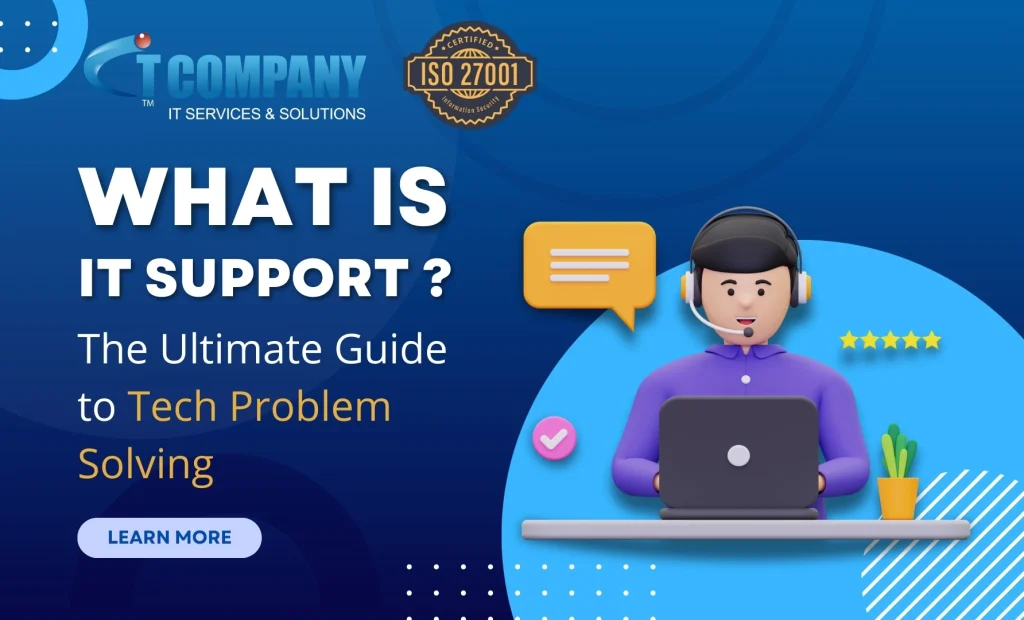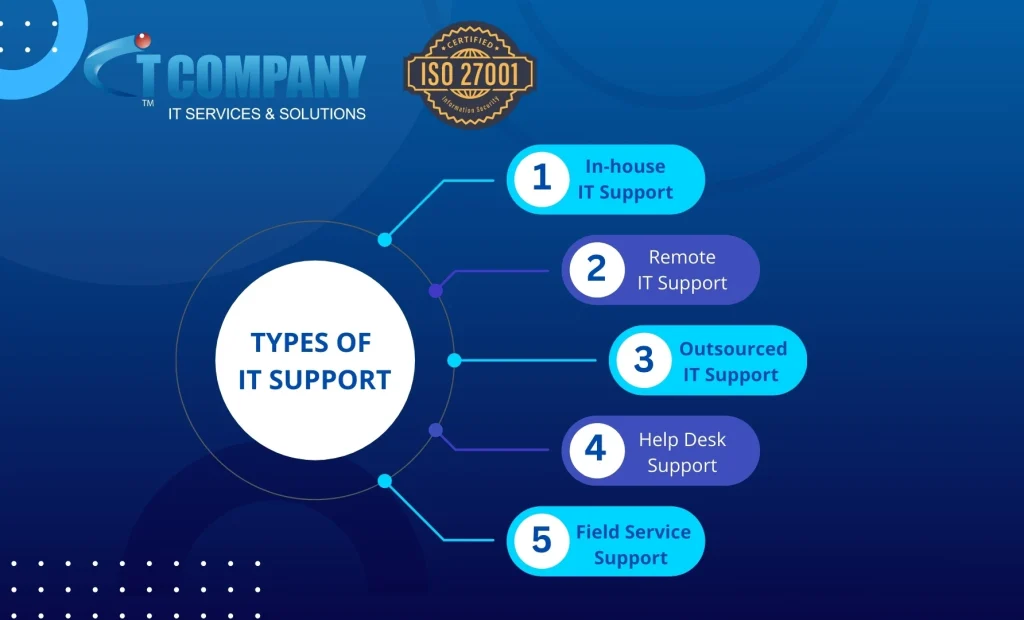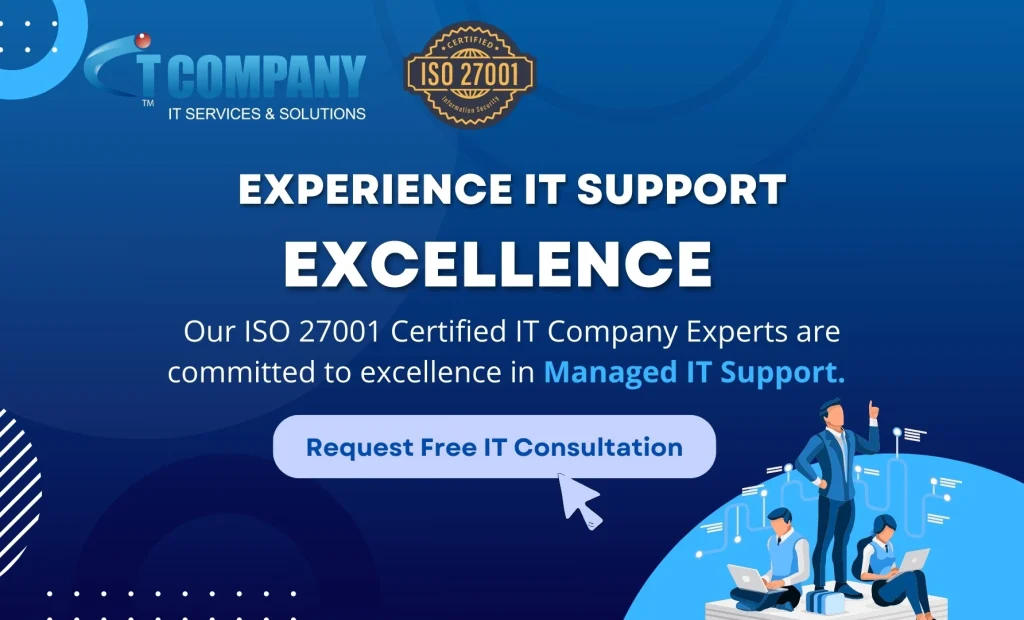
Table of Contents
ToggleDid you know that 80% of businesses experience at least one major IT issue yearly? Or that companies lose an average of $5,600 per minute of downtime due to IT disruptions? As technology becomes increasingly integral to every aspect of our lives and businesses, the role of IT support has never been more crucial.
IT support, often technical help, is the unsung hero that keeps our computer systems, software, and networks functioning seamlessly. It encompasses a broad spectrum of services, from resolving basic hardware and software problems to tackling complex network issues. In fact, over 90% of organizations report that timely IT assistance is essential to maintaining their operational efficiency and competitive edge.
For businesses aiming to stay ahead, partnering with an ISO 27001-certified IT company offers a significant advantage. This certification, awarded to firms that meet rigorous standards for information security management, ensures that your data and systems are protected by best-in-class practices. With ISO 27001 certification, you not only benefit from high-quality IT support but also gain peace of mind knowing your information is handled with the utmost security and professionalism.
The Role of IT Support
IT professionals are the backbone of technology management, ensuring smooth and efficient operations for both organizations and individual users. They handle a variety of critical tasks, from troubleshooting technical issues to providing essential user training. Their expertise is vital in maintaining productivity and resolving tech-related challenges effectively.
| Responsibility | Role |
| Troubleshooting | Identifying and resolving technical issues to restore functionality. |
| Hardware and Software Support | Assisting with computer setup, configuration, and ongoing maintenance. |
| Network Support | Maintaining network connectivity and addressing any network-related problems. |
| Help Desk Support | Providing initial assistance and guidance to users facing technical difficulties. |
| User Training | Educating users on the effective use of software and hardware to maximize productivity. |
Types of IT Support
IT services vary based on their scope, delivery method, and the nature of the assistance provided. Here’s a detailed look at the different types of IT support:
Further information resource: Managed IT Services vs. In-House IT: Which is Right for You?

In-house IT Support
Role:
These experts are directly employed by any organization. They are part of the internal team and are dedicated to addressing the technological needs and issues of their organization’s employees.
How They Serve:
They Offer immediate assistance and a deep understanding of the company’s systems and processes. And personalized and proactive help tailored to the organization’s needs.
Remote IT Support
Role:
Delivered from a distance using communication tools such as phone, email, or remote access software. IT professionals can troubleshoot and resolve issues without being physically present.
How They Serve:
They provide quick resolution of issues and can be more cost-effective as they handle problems efficiently across different locations without the need for on-site visits.
Outsourced IT Help
Role:
Provided by third-party IT service providers who are not part of the organization. These external experts offer a range of IT services on a contractual basis.
How They Serve:
They offer access to specialized expertise and advanced technology without the need for in-house resources. They are more scalable and flexible, as they allow organizations to adjust services based on their needs.

Help Desk Support
Role:
The first level is often provided via help desk support, where users can report common technical issues. Help desk professionals handle basic problems and provide solutions or escalate issues as needed.
How They Serve:
They provide initial assistance and quick resolutions for common issues. They also help to filter and prioritize more complex issues that require specialized attention and expertise.
Field Service Support
Role:
On-site help is provided by IT professionals who visit the location to address hardware-related issues and perform repairs or installations.
How They Serve:
They are dedicated to resolving problems that cannot be fixed remotely such as physical hardware malfunctions or installation. They ensure hands-on experience for complex issues that require direct intervention and fixation.
The Importance of IT Support
Effective IT support is essential for several reasons:
- Increased Productivity: Resolving technical issues promptly minimizes downtime and improves employee productivity.
- Prompt Resolution: It is advantageous as prompt resolution of technical issues minimizes downtime and improves employee productivity.
- Cost Reduction: Preventing equipment failures and data loss can save significant costs.
- Improved User Satisfaction: Providing timely and helpful support enhances user satisfaction.
- Security: helps protect systems and data from cyber threats.
5 Steps – IT Services
It involves a systematic approach to ensuring smooth workflow and productivity by addressing IT-related problems through the following steps:
Step 1: Incident Identification and Reporting
Description: The process begins when a user or system identifies a problem or potential issue. This could be a reported issue from a user, an automated alert from monitoring systems, or a detected anomaly.
Actions Taken:
- Users report issues through a help desk or ticketing system.
- Automated monitoring tools may flag potential problems.
- Initial details about the incident are gathered, including error messages, system performance data, and user-reported symptoms.
Step 2: Assessment and Diagnosis
Description: IT professionals assess the reported issue to diagnose its root cause. This step involves analyzing the symptoms, reviewing system logs, and conducting preliminary troubleshooting.
Actions Taken:
- Review of the incident details and reproduction of the issue if possible.
- Analysis of logs, error messages, and system configurations.
- Identification of potential causes and evaluation of common solutions.
Step 3: Resolution and Repair
Description: Once the issue is diagnosed, IT support technicians implement the necessary fixes or workarounds to resolve the problem. This step involves applying solutions, making configuration changes, or performing repairs.
Actions Taken:
- Execution of specific corrective actions, such as patching software, reconfiguring settings, or replacing faulty hardware.
- Testing to ensure the issue is resolved and that no new problems have been introduced.
- Verification with the user to confirm that the solution is effective.
Step 4: Documentation and Communication
Description: After resolving the issue, experts documents the incident and the steps taken to address it. Effective communication with the user is also crucial to ensure they are informed about the resolution.
Actions Taken:
- Recording detailed information about the issue, resolution, and any follow-up actions in a ticketing system or knowledge base.
- Communicating with the user to summarize the resolution and any necessary instructions for future prevention.
- Updating internal documentation to help with future incidents.
Step 5: Follow-Up and Prevention
Description: The last step involves reviewing the incident to ensure the problem is fully resolved and taking preventive measures to avoid recurrence. This step may include additional checks and updates to improve system reliability.
Actions Taken:
- Conducting a follow-up check to ensure the issue remains resolved and no further complications arise.
- Analyzing the incident to identify any potential improvements or preventive measures, such as applying software updates or revising security protocols.
- Providing feedback and recommendations to users or the organization to enhance overall IT system performance and prevent similar issues.
Conclusion
As technology continues to evolve, the complexity of IT environments grows, necessitating robust and reliable services. To safeguard your organization’s critical data and systems, consider partnering with an IT company that adheres to stringent security standards like ISO 27001.
Remember, a proactive approach to IT support can prevent costly downtime and potential data breaches. Don’t compromise on the health of your IT infrastructure; choose a partner committed to excellence and security.